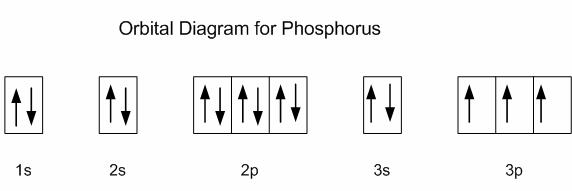Question #37699
1 Answer
Before writing any quantum numbers for phosphorus' five valence electrons, let's write the atom's electron configuration, since this will give you an idea on what you're dealing with.
Phosphorus is located in period 3, group 15 of the periodic table and has an atomic number equal to 15. This means that neutral phosphorus has a total of 15 electrons surrounding its nucleus.
Now, orbitals are filled in order of increasing energy using a set of rules called the Pauli-Aufbau-Hund rules.
http://www.chemguide.co.uk/atoms/properties/3d4sproblem.html
So, when filling orbital diagrams, start from the lowest-energy orbitals and work your way up. A very important thing to remember is that same-energy orbitals must be fully filled before moving to higher energy ones.
So, if you start filling the orbital diagram for phosphorus, and keeping in mind that electrons will rather occupy empty orbitals on the same energy level before pairing up with another electron that's already present in that orbital, you'll get something that looks like this
 http://www.chemprofessor.com/quantum.htm
http://www.chemprofessor.com/quantum.htm
Now for the quantum numbers that describe the five valence electrons. As you know, there are a total of 4 quantum numbers
 http://figures.boundless.com
http://figures.boundless.com
Notice that all five valence electrons are on the third energy level, which means their principal quantum number will be n = 3.
The angular momentum quantum number, or l, describes the shape of the orbital in which an electron sits, the magnetic quantum number, or
So, here are the four quantum numbers for each of the five valence electrons
In order, the electrons described will be
(1) - this is the first electron placed in the 3s-orbital; notice that it has spin-up;
(2) - the second electron placed in the 3s orbital; this one must have an opposite spin, that is why it's spin-down;
(3) - the first electron in the 3p-subshell, more specifically in the
(4) - the second electron located in the 3p-subshell - notice that it's placed in the
(5) - the third electron located in the 3p-subshell - this time in the

